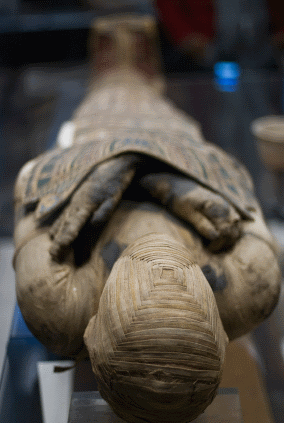|
The Importance of Mummification to the Ancient Egyptians
The ancient Egyptians use mummification as means to preserve a body. For thousands of years, they used this technique out of their firm belief in afterlife. The body must be prepared well for them to have a prosperous life in eternity. In courts, punishing a criminal by denying him proper burial will scare the living hell out of him! Demons will forever hunt them in the underworld. Scary, but true.
The mummy of an Egyptian pharaoh How to Mummify a BodyBefore mummifying a person, imagine someone shouts to the community that a person recently died. People then prepares for the mourning ceremony. Although this sounds like a script in a movie to you, jobs are everywhere for professional mourners in ancient Egypt!
The embalmers wash and shave the deceased body at the Nile River. Gas masks don't exist yesterday so they must do everything for the body to smell clean. At their workshop, the embalmers gather their equipment before working on the brain. To remove the brain, the embalmer inserts a hook through the roof of the nose. Pushing it back and forth, the brain breaks into several pieces. The brain takes a beating until the pulp drains through the nose. To dissolve the remaining pieces of the brain, the embalmer injects a fluid that consists of juniper oil and turpentine into the nasal cavity. With the sticky remains of the brain removed, it leaves a trail of a squeaky-clean, hollow skull. The embalmer opens a slit in the abdomen to remove the internal organs of the body. The internal organs are discarded except the lungs, liver, intestines and the stomach. Believed to be the container of soul, the heart remains inside the body. To prevent a smelly cavity, they use palm wine with spices to clean and disinfect it. A follow through of sawdust, linen, resin, and other aromatic substances fills the cavity before sewing the incision. For 40 days, the sun bakes the body with natron, a natural salt found in Egypt. Remember the internal organs? The embalmer washes and also dries it on the sun with natron. The canopic jars that represent the 4 sons of Horus will house the dried organs and to be kept in the tomb. The body burns and dehydrates under the sun until tanned like a smoked barbecue. The embalmer needs to apply gums and resins to the body to repel insects from destroying the body. With bugs flying around the workshop, you don't want them to lay their eggs on the body and make it their nest! Time to wrap the Egyptian mummy but first, we need two things, a priest wearing an Anubis mask to do the job, and a very, very, very, very, very long linen wrap! Meticulous embalmers wrap the mummy up to 40 layers of linen! With that amount of linen, a poor family asks mummy wraps from charity. While wrapping the dead, different kinds of amulets are placed and the priest recites incantations to conclude the ancient Egyptian mummification process. The embalmer delivers the wrapped body to its family for burial. Whew! The painstaking process seemed like an open heart surgery. But remember, the mummies are in the mercy of the embalmers. One mistake and game over! The Budget MummyOnly the rich and famous Egyptians are capable of expensive mummification. For the less fortunate ones, an alternative mummification process is to inject the body with a liquid similar to what can dissolve the brain. The innards of the body is then drained from the anus before drying it in the sun with natron. It doesn't matter to the Egyptians how they are mummified. Like in our standards today, brushing your teeth and going to school early prepares for our future career. For them, being dehydrated in the sun prepares their future afterlife! Return To... Return from Mummification to Egyptian Burial Customs
|
